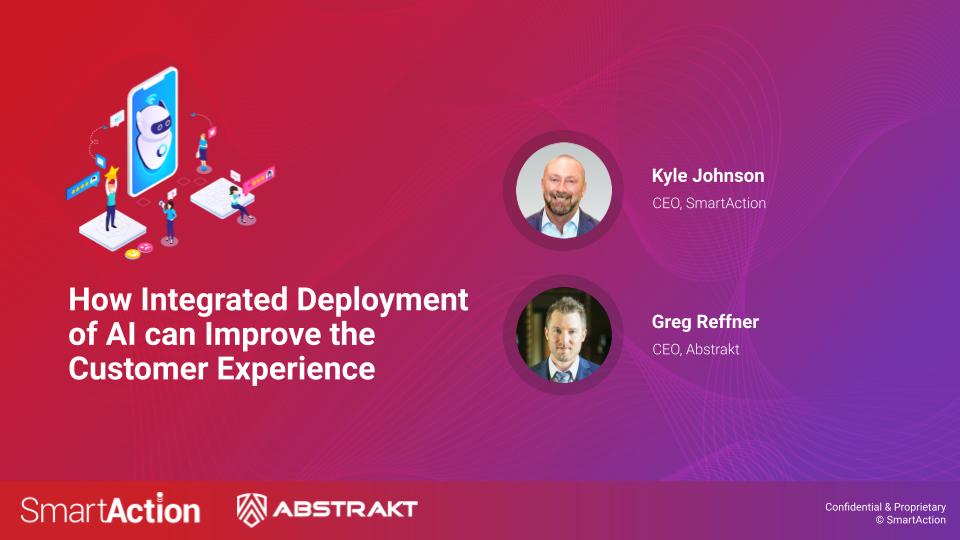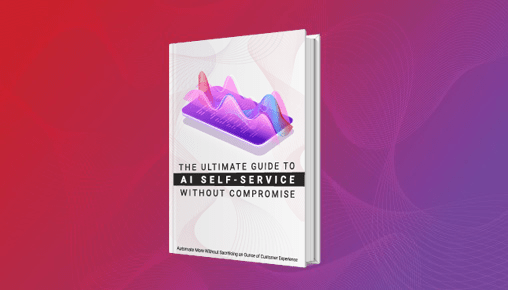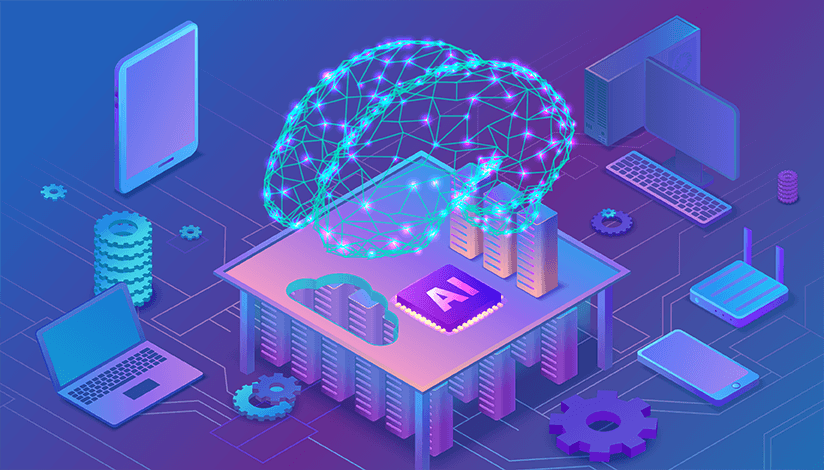How Integrated Deployment of AI can Improve the Customer Experience

AI is changing the customer experience throughout the entire customer journey — from the buying process to service and support. It is also improving the interactions customers have with both live and virtual agents. When implemented correctly correctly across all types of contact center agents, AI improves customer engagement, while increasing operational efficiencies in the contact center.
In this webinar, learn how to deploy AI to seamlessly integrate virtual and live agents, for a positive and profitable customer experience.
Key Takeaways:
- Advancements in AI for contact centers and the challenges they address
- Key benefits for contact center operations and customer engagement
- Best practices for implementing AI and pitfalls to avoid
Watch This
Webinar

Kyle Johnson
CEO,
SmartAction

Greg Reffner
CEO and Founder,
Abstrakt
How Integrated Deployment of AI can Improve the Customer Experience
On-Demand Webinar
Nan Hill (Host): So welcome, everybody. Thank you for participating in today’s discussion about AI in the Contact Center to improve the customer experience. I’m Nan Hill (Host). I’m a marketing manager at SmartAction and I’m your host today. Before I introduce the speakers, I just wanted to cover a couple of things. This webinar is about 25 minutes long with a few minutes at the end for ongoing discussion and question and answers, so please feel free to ask your questions throughout the webinar. I’ll present them at the end. We’re also recording the webinar so that we can send it to you afterwards and the webinar will also be available on our website at SmartAction.ai and Abstrakt.ai.
So now let me introduce the speakers we have today. Kyle Johnson. Kyle is the CEO at SmartAction. Kyle brings over 25 years of experience leading software and technology organizations with a focus on delivering world-class customer experiences. He is leading SmartAction to the next generation of complex virtual agent interactions and conversational intelligence solutions. So say hello, Kyle.
Kyle Johnson (CEO at SmartAction): Hey, guys.
Nan Hill (Host): Also speaking today will be Greg Reffner. Greg is the CEO and founder at Abstrakt and as one of the very first power users of conversational intelligence as account executive. Greg fell in love with how the technology has enabled his success as Abstrakt leader, his vision and why is to give every agent and leader the tools they need to succeed.
Greg Reffner (Founder and CEO at Abstrakt): Thanks for having me. I’m excited to be chatting with you both.
Nan Hill (Host): So we are excited to share these insights with you and hope that everyone participating finds this webinar educational and informative. So now I’d like to hand it over to Greg and Kyle to introduce SmartAction and Abstrakt and why they’re presenting together today. So take it away, please.
Kyle Johnson (CEO at SmartAction): Great. Thank you. Greg, I don’t know if you caught it. I think that we thought we had like, I don’t know, 45 minutes to talk and Nancy 25. So we’re two sales guys and we are going to have to really condense this thing. But no, in all seriousness — Nan thank you. First off for the intro and to all the folks that have joined us here live and those that will watch the recording later on, I really do appreciate you making the time to learn more about our solutions and being willing to invest in improving your own business and customer experience.
I will say as well, it’s great to share the screen here with Greg as he has really invested his time, his money, his blood, sweat and tears quite literally into building an incredible AI solution for contact centers as well. Greg and I first met about 6 or 7 years ago. He was the head of sales actually for one of the companies that I was on the board of. And he identified that there was this huge pain point and gap with, you know, reps and selling agents. And so he made that really scary leap to go build a solution and solve the problem with Abstrakt. So it’s an honor to get to sit here with you today Greg and talk about the solutions together.
Greg Reffner (Founder and CEO at Abstrakt): Yeah. No, no pressure.
Kyle Johnson (CEO at SmartAction): Right. All right. So you know, why are we here together? So, you know, I’ll kind of start by saying there continues to be this groundswell of interest in AI and more specifically conversational AI. And a lot of that’s thanks to the emergence of ChatGPT. Everyone’s kind of heard of ChatGPT at this point. And the funny thing is there’s still a lot of confusion around things like what is AI exactly and is it right for my business. And for those that are newer to the conversation around AI, that’s usually the questions they have.
There’s also though, this big question of how do I implement an AI solution into my business? And with so many different ones out there, what do I choose and how do I make sure they work together? So those are really the things that Greg and I are going to try to answer during our time today. But really with the larger focus on that ladder, which is how can an integrated deployment supercharge my business? So Greg, I don’t know if you had any additional thoughts there.
Greg Reffner (Founder and CEO at Abstrakt): Yeah. I think the biggest thing that you brought up, Kyle, is kind of how does AI fit into my business? Whether it’s through the virtual agent or the live agent, where does it fit? How does it fit? What should we be looking for AI to do? I’m excited to dive into those questions with you today.
Kyle Johnson (CEO at SmartAction): Perfect. So you know, live agents, virtual agents and the integration there, I think, with an IVA tool, an IVA is intelligent virtual agent like SmartAction. You know, one of the KPIs that we focus on is containment, right? Essentially, our goal is to contain as much of the customer interaction as possible or as the businesses that we partner with and use the solution want, on our platform to free up the live agents to handle the more high-value customer interactions. And you know, we’ll talk more about why a business would want to do that in the next couple of slides.
But there’s always going to be a portion of calls that do transfer from that IVA to a live agent or even go directly to the live agent from the start, right? Which is really where Abstrakt takes over. So ensuring that there’s integration or really continuity within that handoff is incredibly important.
Greg Reffner (Founder and CEO at Abstrakt): Yeah. And to add to that, once that handoff takes place or if it goes straight to an agent, historically agents have been kind of left to figure some stuff out on their own or they have their slides and their docs and everything. And so again, where does AI fit in that handoff? And how does technology enable that agent to deliver or be able to deliver that customer experience even better than they already are today? And so again, everything revolves around how do we make sure that customer is as happy as possible while doing more with less at that agent level once it gets to that agent. So again, we’ll dive into these topics here in the next couple of slides.
Kyle Johnson (CEO at SmartAction): Certainly. You know, another big part there. Sorry. I think I just took over your part, Nan, I’m sorry. But you know, another big part there is improving, you know, the customer experience as a whole. And so, you know, it’s another huge benefit that our customers recognize. You know, I’ve often said that, you know, an IVA never has a bad day when agents sometimes do, right? So you get a very consistent experience with an IVA solution.
Another customer-focused reason that you might want to deploy an IVA or AI solution is it dramatically reduces wait times, instead of waiting for a live agent to become available. The IVA can handle those basic and sometimes fairly complex tasks or questions that a customer may have.
Nan Hill (Host): So thanks for that context. For more context. Can you share with us what’s going on in today’s contact center?
Kyle Johnson (CEO at SmartAction): Yeah. So thank you. Thank you for that. Today’s contact center. Obviously, we have a few things listed here, and customer expectations are pretty high. And so as a contact center manager or technology provider, you have to make sure that you’re meeting the customers where they are and how they want to be serviced. Customers don’t want to sit on hold. And, you know, even though really both of the platforms that are on today and being represented are voice first, sometimes they don’t want to have to talk to a live agent. Right. And so, quite frankly, you know, they want multiple avenues of communication and contextual communication across those platforms.
And so think voice, think text, think apps or SMS. And so whatever solution you choose, you have to be able to integrate across really the suite of products or technologies that you use to support your business. Customers also expect a great and consistent service every single time.
Sadly, I can think of dozens upon dozens of experiences that I’ve had personally where I’ve reached out to a company that I’m a customer of for some type of support or service. And I’ve gotten vastly different levels of service or support from that company. You know, sometimes you have to call back and talk to a different agent. You get a completely different experience. So that level of customer service or maybe sometimes customer disservice can be incredibly frustrating and I think people understand that. So, you know, the really cool thing here is both of these solutions either provide or enable a rep to provide the same level of experience with every single interaction.
Greg Reffner (Founder and CEO at Abstrakt): So to that point, Kyle. Call volumes are increasing. I think agents are being asked to do more with less, Right. They’re not hiring double triple number of agents. And so the same number of agents needs to handle the higher volume of calls, which leads to agent turnover. You’re getting agents that are getting frustrated at a faster rate and they’re quitting and you’re having to backfill those positions. And so again, leveraging technology to help agents maybe automate away some of the mundane tasks or the repetitive tasks in their day to day allows them to handle higher call volumes at a higher level of service for that end customer while decreasing that agent turnover because they’re happier, they’re not getting beat up every day on the phones. They’re able to automate some of the things they don’t like about their job. And so I think all of these start to go kind of hand in hand and I think we’ll kind of continue to explore that throughout the rest of our time together today.
Kyle Johnson (CEO at SmartAction): Yeah, absolutely. You know, you touched on some really good points there. You know, call volumes are going up constantly. And you know, I’ve seen several reports recently around you know you hear sometimes, ‘oh, voice is dead’. It’s not like we see the minute usage across platforms that employ voice solutions continues to increase. And so, you know, if you’re a contact center manager, you’ve got, you know, several options, right? You can go hire more reps, you can provide a lower level of service or provide decreased levels of SLAs – which no one’s really going to want to do. Or you can use technologies that allow your business to scale at really a fraction of the cost and time. And so, you know, the great thing about a lot of these solutions and IVA solutions is, you know, we can handle large volumes of calls without ever getting that busy signal or without having to wait for that agent to become available. Because you have basically unlimited channels as it comes in and hits the platform And then love what you said, Greg, on the agent turnover side. It’s really cool to see how these types of technologies can help reduce churn, even agent churn. And so, you know, I was just at an event a few weeks ago and had the opportunity to meet with dozens of call center technology managers and decision makers. And one of the things that was interesting that they shared with me was that they listened for the things that their reps complained about, right? So, you know, meaning the types of calls that reps complain about and you know, maybe it’s things like, you know, I think you mentioned the word mundane, right? So the mundane tasks like checking a balance or you know, giving an update or inventory tracking or things like that. So those folks are looking to automate those processes which then can increase agent satisfaction with the types of calls they are handling. Right? They feel like they’re handling the more high-value customer transaction than just kind of the really like mundane, mindless day to day type activities. And so that’s another one of the things that, you know, again, we’re hearing it, we’re hearing it real time. And so it’s a it’s a huge benefit. Um, and then you talk about kind of this balancing act, right, of, you know, between virtual and live agents. And really it’s not as difficult as it sounds. It really is up to the business as to the type of experience they want to deliver and provide. And so the other great thing about the solutions that we provide and I know we’ll touch on it in a second is, you know, the ability to scale up or scale down the solutions pretty much instantaneously, right? And so if you notice that, you know, you’re not quite getting the experience that you want for your customer, it’s very easy to go in and make that update so that you can provide that consistent in that world class level of experience.
Nan Hill (Host): Right. Excellent. So if those are the call. Call center challenges. What are some of the benefits AI will bring to the call center to address them.
Greg Reffner (Founder and CEO at Abstrakt): Yeah. So I think the first thing is the ability to quickly scale up and scale down as demand necessitates. So one of the hardest things to do is hire people. Competitive landscape, job market. Where all every company is looking for the best talent possible. And so whether it’s the IVA trying to contain the call up front, we need to add more containment up front or we need to help agents onboard faster through software that is helping them in real time while they actually are live on the call. Software allows us to scale up and scale down and I think it indirectly allows you to hire maybe a little bit faster people, especially when we start talking about agents that need to be on the phone, because software is going to help onboard them faster. And so we don’t have this like three, four month waiting period before somebody is fully ramped because software is helping that person ramp up faster. So whether we’re trying to contain up front or we’re trying to onboard people faster and scale up resources to meet a higher demand or even scale down, technology allows us to do those things kind of pretty easily actually.
Kyle Johnson (CEO at SmartAction): Yeah. And you know, Greg talked about scaling up and he’s right like hiring folks, especially in today’s market. And I think a lot of our a lot of our folks are probably feeling that pain as well. It’s an interesting labor market still. And so hiring folks is hard and it’s time consuming. And so from a processing standpoint, that’s exactly right. Sometimes it’s even harder though, on the scale down portion because there’s also this component of like, you know, your humanness and you have people, right? And so it’s not like you can just, you know, turn a person off, right? And so, you know, that being able to scale down piece of it is also what is difficult. And so again, using technology that better balances the flow of your calls and that customer experience to an agent versus an IVA is another big benefit there. You know, the other thing here we talk about is, you know, the improved customer experience there across channels. And so that’s the other big thing that that we see from a lot of our customers is, you know, there’s this fear sometimes that if you use an IVA solution or an AI solution in general that you lose a little bit of that human touch. And so I don’t want to dismiss that. That’s a real that’s a real concern What our customers data and response to us is validated though, is that in general we see the same if not better CSAT scores because of that consistent experience. And then when you think about taking both the pre agent and the once it gets to the agent type of AI software and putting them together, you really have more of that integrated experience, right? So think the scripting, the tone of the call and the support that you want to provide being very consistent from the IVA all the way to that live coaching solution as well.
Greg Reffner (Founder and CEO at Abstrakt): Consistency I think is key there, right? In every aspect of business we’re trying to look for repeatability and when you don’t have consistency, it’s kind of hard to measure what’s working and what’s not working. Um, and to the last bullet point here, one of the amazing and surprising things for me has been how our customers are looking at Abstrakt is impacting both top line growth as well as bottom line impact. Um, it’s very rare to be in a position where you can impact both sides of that spectrum. And so we look at, you know, if we’re using an IVA, can we automate options to promote offers? Um, can you know, once we get to an agent’s level, if somebody’s talking about certain product, can we automatically prompt them to recommend another product and then bring it all the way down to efficiencies which we’ve already talked about before. You’re impacting the bottom line by getting more out of the people you already have. So it’s um, you know, you see AI’s impact across the revenue life cycle and it’s pretty cool to see what our customer is able to do with solutions like SmartAction and Abstrakt.
Kyle Johnson (CEO at SmartAction): Yeah, it is really cool and you nailed it right? It really accomplishes both. And a lot of technologies or processes that you implement, you’ve got to pick one or the other and that’s a really cool thing here is you kind of get both and you gave some of the examples. Maybe it’s, you know, qualification on the front end that saves time from an agent and an upsell campaign or maybe it’s better understanding buyer intent so that you send it to the right channel to begin with. So a lot of those things that can reduce your overall costs but can also be revenue drivers for you as well.
Nan Hill (Host): Great. So for contact centers and contact center leaders who are thinking about deploying integrated AI across virtual and live agents, can you share some of the things that they should keep in mind for implementation?
Greg Reffner (Founder and CEO at Abstrakt): Yeah. So for this. This one’s my favorite quotes ‘Is the juice worth the squeeze?’ So you have the upfront resources needed to evaluate solutions on the market. Once you have solutions identified, then there’s the planning that goes into implementation. There’s the resources that are needed for implementation and you do all these things with the expectation of some longer term benefit. And so I think just one of the big things is, you know, what you’re thinking of using AI and software to solve for — is it the right thing to be looking at trying to impact? Are there other areas of the business that you should be looking at trying to impact, which kind of ties into number four down at the bottom, but just make sure that you’re looking at solving the right things because it is an investment of time and it is work up front. So I think that’s one of the big things that we always ask our customers to really kind of be honest with themselves about.
Kyle Johnson (CEO at SmartAction): Yeah. You know, the other one is, you know, how do we start implementing this, right? Is it complex versus simple? And then, you know, what problems are we trying to solve? And you know, so we’ve seen customers and I think Greg would probably echo this across both parts of the business that um that do it both ways, right? You have some that say hey we want to tackle this one specific part of our call flow, right? Or this one specific campaign that we’re running, right? We want to utilize those technologies to assist our agents or to handle the call flow in the beginning. And so what I would say is, you know, there’s a lot of knowledge with customer interactions and best practices that we’ve got in both organizations that we would share based on the types of use cases you’re considering. And so those are the questions to ask and I think it’s worth that conversation when you kind of get into, you know, discovery and solution with these technologies is what do we think is the right way to start in our particular instance?
Greg Reffner (Founder and CEO at Abstrakt): Yeah, crawl, walk, run is what we always advocate for because you end up learning a lot throughout the process of tackling maybe a smaller chunk first. Um, and so, you know, complex versus simple. We always say, ‘hey, you know, this is going to be new for your agents, this is going to be new for your leadership team. This could be a huge leap forward for your business in a lot of ways.’ Behavioral change management is one of the hardest things. And so if we can take that off in smaller chunks, it tends to lead to better results. And so at least from our side, Um, anything to add to that?
Kyle Johnson (CEO at SmartAction): I think you nailed it. Um, you know, the other big thing that you touched on there at the beginning too is, you know, measuring ROI, right? So is the juice worth the squeeze? And so what I would say is, you know, there’s I’ll focus on kind of the SmartAction part first. You know, we actually have a very easy to use ROI calculator, right? That with your specific business inputs, you know, things like number of calls and average handle time and things like that that can give you an expected savings on just the call handling portion of the technology. Right? So we’ll show you what it would look like to utilize that versus it being sent to a live agent from the start. But there’s so many other factors that go into analyzing ROI, right? So that’s the simple, easy one that’s up front. You know, some of the things we’ve talked about, right? Like, you know, increasing customer satisfaction, right. Which I think we all know has positive impact on your business. Um, increasing one call resolution, right? So not having to sit and make multiple calls to solve for the same problem, Um, things like increasing your conversion rate in the case of order, placing things like that. So there’s a lot of different ways. There’s a simple and upfront way with ROI calculators, but there’s a lot of the other kind of deeper into the business process intangibles that really do have a positive impact on the business. And so you want to make sure when you’re considering a solution that you really think through, what are all the ways that this touches the customer and positively impacts our business?
Greg Reffner (Founder and CEO at Abstrakt): Yeah. Love it. Mean for once it gets to that agent. The biggest thing our customers look for is decreased call handle time or increasing first call resolution. So if we can do more with two agents and AI than we did with three. You know, that’s a bottom line impact. And especially if those agents are able to identify upsell opportunities or reduce churn risk, things like that. Now we’re impacting the top line. We don’t have a fancy ROI calculator yet, but those are the types of things our customers are looking at. Um, how to how to measure the ROI of investment in technology like ours.
Nan Hill (Host): All right. So before we start the Q&A session, Kyle, would you mind summarizing why Contact Center should consider implementing AI across live and virtual agents?
Kyle Johnson (CEO at SmartAction): Yeah, absolutely. Dan. Thank you. So, you know, I think that there’s if we had to summarize it into four things, we’ve got them here listed on the screen. It’s a better customer experience, right? So being able to control and have consistency of customer experience, you know, across the entire call journey is incredibly important. And so things like that also help drive that customer retention and drive brand loyalty. And so again, great way to think about it. You know, more cost, lower cost, pretty simple, right? Like that. That’s the thing that probably resonates with most business minded people is how do I handle more for less? Right? And so both of these platforms allow that. How do I then increase revenue, especially if you’re sales focused, if you’re a head of revenue, I mean, that’s something that’s constantly on your mind. And so what are the ways I can utilize different solutions to drive more revenue into the business? Big reason to consider this. And then at the end of the day or like are your agents happy? Right. Because you know, it’s all about the people. And so even though we’re providing solutions that are AI powered, it’s all about how we provide a better experience, whether it’s to our customers or to our own agents. Right? And so those are some of the big reasons that I think would summarize and being like, here’s why you should consider these types of platforms.
Greg Reffner (Founder and CEO at Abstrakt): I would just reiterate I’ll just copy and paste what Kyle said and.
Nan Hill (Host): All right, Thank you. We did have a couple questions come in. Actually, there’s three. The first question is can you provide an example of a few features which allow the technology to help onboard new employees?
Greg Reffner (Founder and CEO at Abstrakt): So one of the things in Abstrakt is recommended responses. So Abstrakt is listening to the conversation and in real time about 0.2 seconds based upon what’s being said pops up a recommended response card for the agent and how to handle that question. And so a lot of our customers are looking at, you know, how do I handle complex technical questions or how do I walk somebody through the steps to accomplish X, Y, Z within their account? Those recommended response cards are helping those agents instantly know how to answer those questions so they don’t have to memorize them. They don’t have to know where to go look for them. We’re delivering that to them live while they’re actually on the call with that customer. So that’s an example of one of the things within Abstrakt.
Kyle Johnson (CEO at SmartAction): Yeah. And I think um, you know, one of the ways I would relate that back to the SmartAction platform as well is, you know, if you are reducing the number of types of transactions that a rep has to handle, right? So if you push, you know, maybe there’s 15 core tasks that a rep handles and you’re going to push five of them to an IVA platform, then that is now reducing the amount of things that they have to learn as a brand new rep as well. Right? So we’re going to handle these five inside of an IVA platform. You focus on being an expert in these other ten, right? So I think maybe that’s another way to think about how that would also reduce some of the onboarding time.
Nan Hill (Host): Great. All right. Second question. Our IVR system seems to be working fine for customers and agents. Why is AI better than our existing IVR and will it really improve the lives of our agents? What metrics will improve with AI?
Kyle Johnson (CEO at SmartAction): Yeah. Really good. Yeah. Really good question. Or group of questions. Right. So IVR solutions have been around for a long time, right? And so if you look at what an IVA solution provides is. It can do everything an IVR does. Now, again, I wouldn’t recommend that if you’re just looking to simply replace an IVR that you would put an IVR solution in place. But it will do that. You just you’re going to have way, way too much horsepower for the for the car that you’re putting it in. Right. So what an IVA solution does is it’s actually directing the call through that human interaction. Right? So it’s the AI platform that’s providing a very human like experience, but it also then is processing those types of requests for you. And so again, you can better direct the customer experience by not ‘press one for sales, two for customer service, three for X, Y and Z’. Right. But actually directing them through a normal conversation to what they’re trying to solve for. And it also doesn’t necessarily have to be in the same line, right? So if you think about an IVR, if you press one for sales, you’re in a sales path and that’s it. And then if something pops up where, oh, now I need a customer service type issue handled, now I’ve got to sit and wait until I’m transferred to a customer service rep that can handle that. And the way the IVA solution works is it is it is programed, if you will, to learn how to handle all of these things and that kind of single linear transaction. And so that’s one of the ways that you can think about how it provides a better experience and better solution. And then the KPIs that you would expect. Again, you look at average handle time, you look at the one call resolution, how many people had to touch that and what was the cost to service that particular customer or call? Those are all the types of KPIs that are positively impacted there.
Greg Reffner (Founder and CEO at Abstrakt): I think about Google when you think about long tail search phrases, when you go like you mentioned conversational, right? You want that human like interaction. One of the things like Google values is content that is reflective of natural conversation. So when you type in a search query, right, you type it in how you would say it in Google rewards that. SmartAction IVAs reward human like conversation. And I think we’re seeing a very good evolution to technology supporting human-like interactions. And so I just think it’s there’s some things that aren’t measurable there like, you know, just the fact that it feels more human. I think that’s subjective in a lot of ways. But if we look at the technologies that we like to interact with as consumers, they’re all very human like feeling.
Nan Hill (Host): Yep, that’s actually a good transition to the next question is: we still want to provide a human touch to our customers, but we don’t want our agents to feel like they’re getting squeezed out. With AI, will human agents still play a critical role in the contact center?
Kyle Johnson (CEO at SmartAction): Yeah. Don’t think Sorry, Greg. I’ll take this one first. The human component doesn’t go away. Again, if you think about what these solutions do, they’re actually meant to augment the experience, right? And augment the job that the human actually has to perform. And so I like to think of it like God, I’m trying to struggling for the example here, but like putting on the maybe it’s Iron Man, right? It’s like thinking about what an or what does is like the Iron Man suit. So you got Tony Stark sorry folks out there, right? You got Tony Stark who can only do what a human can do. And so he puts on this AI suit. Right. And it enables him or her to go out and do way more than they could have done by themselves. And so, you know, maybe the suit can do some things by itself, but there’s this other component of what it can’t do. And so I think, again, it’s an augment to the human component of the service that we provide, not a complete replacement for.
Greg Reffner (Founder and CEO at Abstrakt): So I love that analogy. And what’s interesting is we have cars that automatically brake for us when we’re not paying attention. We have appliances in our house that respond to our voice and know when we walk in the door, the lights turn on. We’re already using software and technology to keep us safer, make us more efficient at home. It’s interesting how there’s this cautiousness and uneasiness around applying it to helping people do better at their jobs When all these people are already using this technology in their life – we’re just making their jobs easier.
Kyle Johnson (CEO at SmartAction): So let me let me share my yeah, let me show my age for a second. I came up in the era of typewriters and when you messed up typing something on a piece of paper and you had to put the little white strip there and type over it to get rid of it, and then all of a sudden computers came along and was like, Oh man, am I going to like miss my typewriter? No, not at all. So much easier to backspace now.
Nan Hill (Host): All right. Um, I think we have time for one more question. And we do have one more question. Implementing AI is a significant investment, it sounds like. How do we make the business case and measure for these initiatives?
Kyle Johnson (CEO at SmartAction): So the investment, the majority of the investment and most of these cases is the time that you’ll spend up front. And so one of the things and I won’t speak for Greg and Abstrakt, although they probably have a similar process, is that we invest a lot of time you know, meaning we SmartAction, invest a lot of time really understanding the business so that the solution that we that we build continues to provide again like that same level of customer service that the customer expects. And so we put a lot of time into it up front. The investment on the company side or you know, the customer of our side, if you will, that we partner with is, you know, we have to have access to those things, right? We have to have someone on that side that’s committed to seeing that process through and, you know, having those conversations and making those things available. Right? So it’s really more of, you know, am I willing to put the time in up front, which, you know, it’s hard could you know, maybe we could say here’s how many hours on average it takes of commitment to do that. But when you think about the long term benefit of the solution, it’s going to far outweigh the benefit you get out of it far outweighs the time that you it up front. And so, you know, again, really the way to think about is do you have to make sure there’s dedicated resources there in the beginning to get it launched? Absolutely. You know, if you if you if you think you can do it without that, then there’s probably a missed expectation. But really what you get on the back end far outweighs it.
Greg Reffner (Founder and CEO at Abstrakt): I couldn’t have said that better myself. Kyle. You got to have the on the on our customer side, the vendor looking to deploy AI, We need to have access to that information. We need to understand your business and we need a point of contact or, you know, a couple dedicated points of contact that we can work with to configure the solution. It does take work and I think maybe that might be one of the, the misconceptions around AI out there today is, you know, it needs it needs a little bit of work to get going, but the long term benefits are, again, transitioning from the typewriter to the computer, there was a huge benefit there.
Nan Hill (Host): There is one more question that just came in. Do you guys have another time? Yeah. Yeah, for after implementing AI in the IVR. Do you have a recommendation for sustaining and enhancing the VA? An operating model or a call center or a center of excellence? So sustaining and updating the solution itself, is that specifically what the question is asking in? Yes. You have a recommendation for sustaining and enhancing the IPA.
Kyle Johnson (CEO at SmartAction): Okay. So yeah, that’s a really good question. One of the I’ll say one of the things that really sets SmartAction apart from a lot of other competitors out there is that that is a key component of what we do. So we continue to monitor the performance and the usage on the platform. And so again, back to earlier in the webinar I talked about that containment rate being one of the key KPIs, right? And so what we’re looking to do is we have an expected containment rate when we deploy the solution and we stay attached to our customers and the process and what’s happening on the platform because we always want to continue to drive that containment rate higher. And so we’re automatically going in and reviewing it, making suggested changes. Of course our customers sign off on those changes and say, yes, that works for us and then we implement that into the into the solution. So that’s a piece specifically around the containment rate. And then again, because it’s a cloud solution, you also get the benefit of all of the updates that we do to the platform itself. So feature functionality is automatically deployed out. And so if there are new things that we add, those things you just get – you don’t have to go and uninstall and reinstall like it’s just going to naturally be rolled out to the solution.
Nan Hill (Host): All right. Any other questions? All right. Guess we’ll wrap it up. All right. Again, thank you, everyone, for participating. We’ll be sending a recording to everyone who registered and attended today. And then also the recording will be on our website and give us a couple days to get that up. All right. Thank you. Thanks all. Thanks for having us. Bye, everybody. Thank you.
AI is changing the customer experience throughout the entire customer journey — from the buying process to service and support. It is also improving the interactions customers have with both live and virtual agents. When implemented correctly correctly across all types of contact center agents, AI improves customer engagement, while increasing operational efficiencies in the contact center.
In this webinar, learn how to deploy AI to seamlessly integrate virtual and live agents, for a positive and profitable customer experience.
KEY TAKEAWAYS:
- Advancements in AI for contact centers and the challenges they address
- Key benefits for contact center operations and customer engagement
- Best practices for implementing AI and pitfalls to avoid





